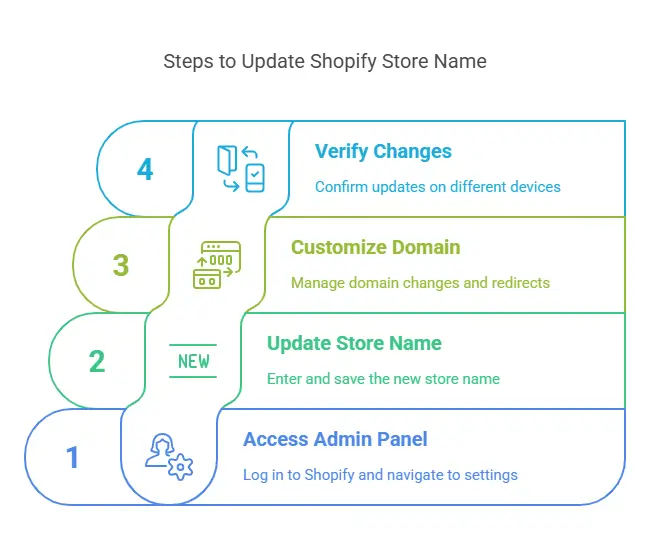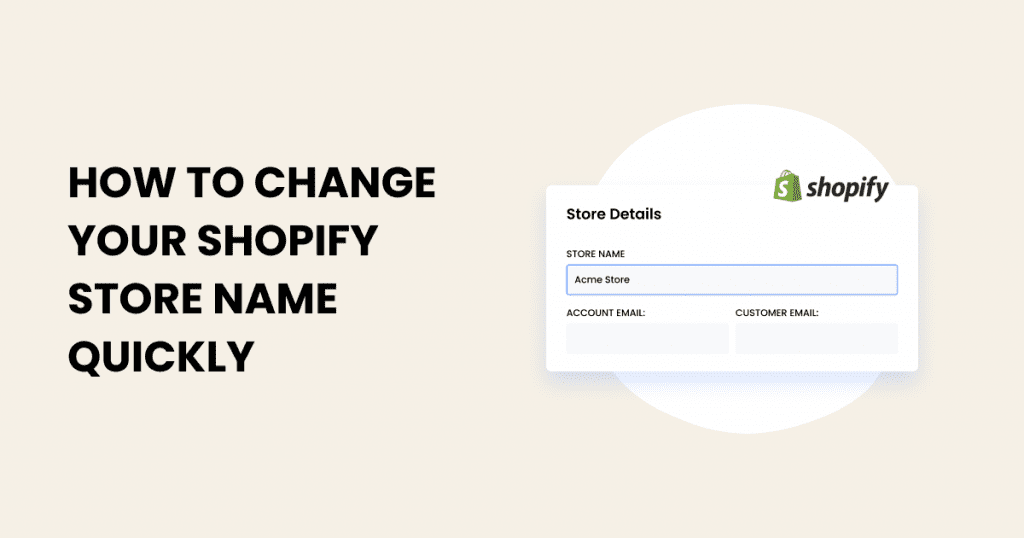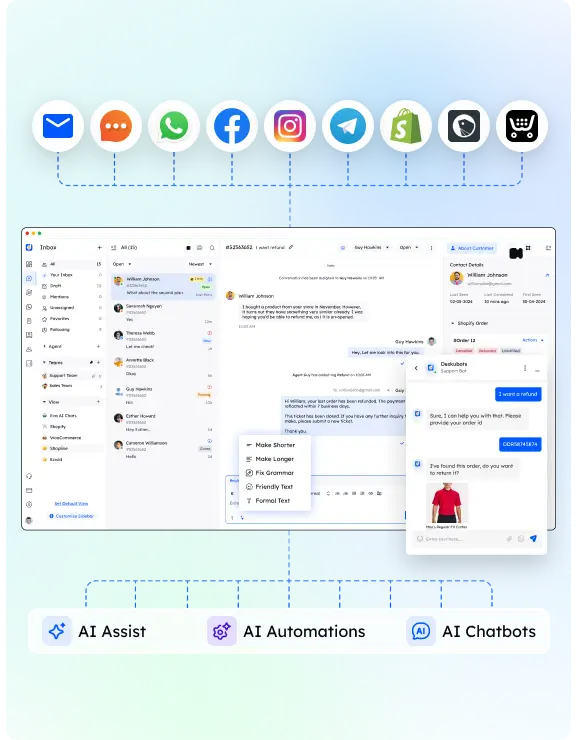Changing your Shopify store name might seem like a small step, but it can have a big impact on your brand. Whether you’re rebranding your business, clarifying your identity, or just making tweaks to better represent your product line, the process is simpler than you might think.
In this guide, you’ll learn how to change your Shopify store name through a simple process in the Shopify admin. We’ll cover everything from updating your store name and domain settings to understanding the implications for branding and SEO efforts. By the end, you’ll know how to align your store details with your new brand.
Let’s get started by tackling the most critical part—changing your Shopify store name and updating the related settings.
Step-by-Step Guide to Changing Your Shopify Store Name

Changing your Shopify store name involves more than just updating the title—it also requires considering your domain, branding, and store details. Here’s a complete guide:
Accessing Your Shopify Admin Panel
- Log in to your Shopify account using your credentials.
- Once in the Shopify admin website, locate the left navigation menu.
- Click on Settings at the bottom-left corner of the dashboard.
Updating Your Store Name
- In the Settings section, select General.
- Find the Store name field under the “Store details” section.
- Enter your new store name. This name will be used for internal purposes and will appear on invoices, notifications, and other administrative areas.
- Once you’ve made the changes, scroll down and click the Save button to apply them.
Tip: Your store icon and branding elements like the store address and logos may need updating to match the new name.
Customizing Your Store’s Domain (If Applicable)
Changing the store name doesn’t automatically update your store’s domain or primary domain. Here’s how to manage it:
- Navigate to the Domains tab within Settings.
- Review your domain list and identify your current store domain or existing domain.
- If you wish to add a new domain name, click Buy a new domain or connect a custom domain.
- For existing domains, you can update the public-facing URL of your store by changing the primary domain.
- If you’ve recently acquired a new domain, ensure your customers are redirected from the old domain to the new one using domain redirects.
Important: This step impacts your shopify url, seo efforts, and overall search engine rankings, so ensure your changes align with your branding and business goals.
Verifying the Changes
After updating your Shopify store name and domain, take these steps:
- Check your store settings section and domains section to confirm the updates.
- Use a mobile device and a desktop to preview your online store and ensure the changes are visible to customers.
Updating your shopify store domain or store name and domain may seem technical, but Shopify simplifies it with its intuitive dashboard.
Things to Consider Before Changing Your Store Name
Changing your Shopify store name isn’t just about updating a field in the Shopify admin. It involves important considerations that can affect your branding, customer experience, and SEO. Let’s dive into what you should keep in mind.
Branding Implications
Updating your store name can signal a new direction for your business, but consistency is key. Ensure your new name aligns with your new brand or product line.
- Update all branding materials, including your store icon, packaging, and invoices.
- Revise your social media profiles and email templates to reflect the new store name.
- Check that your public-facing URL matches your store name for a seamless experience.
Example: If your old store name was “Green Gadgets” and your new store name is “EcoTech Solutions,” update all related branding to avoid confusing customers.
SEO Considerations
Changes to your store name and domain can impact your search engine rankings, especially if you modify your store url or switch to a new domain name.
- Use redirects to ensure customers and search engines are forwarded from your old domain to your new url.
- Update your meta titles and descriptions in the Shopify admin website to reflect the new store name.
- Monitor your traffic and seo efforts after the change to identify any fluctuations.
Pro Tip: If your branding update isn’t tied to your domain (e.g., changing an internal store name), the SEO impact is minimal.
Communication with Customers
Clear communication prevents confusion and builds trust with your customers. Here’s how to announce the change:
- Send an email or newsletter from your Shopify app introducing the new store name and the reason behind the change.
- Use a banner on your online store homepage to notify visitors of the update.
- Reassure customers that their orders, accounts, and interactions with the current store remain unaffected.
Example Notification:
“We’re excited to announce our store name change to better represent our brand and mission. Welcome to [New Name], formerly known as [Old Name]. Everything you love about us remains the same—just under a fresh new name!”
Considering these factors ensures that your name change strengthens your business without causing disruptions.
Common Mistakes to Avoid
Changing your Shopify store name seems like a straightforward task, but there are a few pitfalls to watch out for. Avoid these common mistakes to ensure a smooth transition:
1. Forgetting to Update Branding Across Platforms
Your store name represents your business everywhere. If you change it on Shopify but forget to update it on other platforms, it can confuse your customers.
What to Do:
- Update your social media profiles, email footers, and invoices with the new store name.
- Check for any mentions of your old store name on your online store and correct them.
2. Ignoring SEO Best Practices
Switching to a new domain without planning can harm your search engine rankings. If customers or search engines encounter broken links, your traffic might drop.
What to Do:
- Set up 301 redirects from your old domain to your new domain name in the Domains tab.
- Update your meta descriptions, site maps, and internal links in the Shopify admin website.
- Monitor your SEO efforts to ensure your visibility isn’t affected.
3. Overlooking the Customer Experience
Failing to communicate the changes can make customers think they’ve landed on the wrong site. This can lead to lost trust and even lost sales.
What to Do:
- Use banners, pop-ups, or email announcements to inform customers of the name change.
- Reassure them that the current store remains the same, and no functionality or order processes have changed.
4. Not Testing the Changes
Once you update your shopify store name, failing to double-check the store settings section or preview your online store can result in missed errors.
What to Do:
- Review the store address, shopify url, and branding on both desktop and mobile devices.
- Test links to ensure redirects are working properly.
5. Changing the Name Too Frequently
Frequent updates to your store name can make your brand seem unreliable or unprofessional.
What to Do:
- Think strategically before making a name change. Ensure it aligns with your long-term branding goals and customer expectations.
FAQs About Changing Your Shopify Store Name
Here are answers to some of the most common questions about changing your Shopify store name.
1. Will changing my Shopify store name affect my URL?
No, updating your store name in the Shopify admin doesn’t automatically change your store’s domain or shopify url. Your domain remains the same unless you manually update it in the Domains tab of the store settings section.
If you want a new domain name, you’ll need to either buy one through Shopify or connect a custom domain. Redirects can help ensure customers find your new url without issues.
2. Can I change my Shopify store name more than once?
Yes, you can update your store name as often as needed in the store settings. However, frequent changes can confuse customers and dilute your branding. Always aim for consistency to build trust and recognition.
3. What happens to my SEO rankings after a name change?
Changing the store name alone doesn’t impact your search engine rankings. However, if you update your shopify store domain, it can affect your SEO. To minimize disruptions:
Set up redirects from the old domain to the new domain name.
Update your site’s meta information and store address in the shopify admin website.
Inform search engines about the changes through tools like Google Search Console.
4. How do I inform customers about the name change?
Here are the best practices for communication:
Use Shopify’s email marketing tools to send an announcement.
Place a banner or pop-up on your online store explaining the change.
Update your social media profiles with a message about the transition.
5. Can I update my store name using the Shopify app?
Yes, you can update your store name via the Shopify app. The steps are similar to using the Shopify admin website:
Tap the Settings icon in the app’s left navigation menu.
Go to the General section and find the store name field.
Enter your new store name and tap Save.
6. Is there a difference between changing a store name and a domain?
Yes. Your store name is primarily used for branding and internal purposes, while your store’s domain is your public-facing URL. Updating one doesn’t automatically affect the other.
Conclusion
Changing your Shopify store name can be a big step, but it doesn’t have to be complicated. By following the steps outlined in this guide and keeping key considerations in mind, you can ensure a smooth transition that aligns with your brand and business goals.
Here’s a quick recap:
- Use the Shopify admin to update your store name and, if needed, your store’s domain.
- Plan for potential SEO impacts by setting up redirects and updating meta information.
- Communicate the change clearly to your customers to maintain trust and transparency.
Whether it’s part of a rebrand or just a tweak for clarity, a thoughtful approach will help your business thrive under its new store name.


